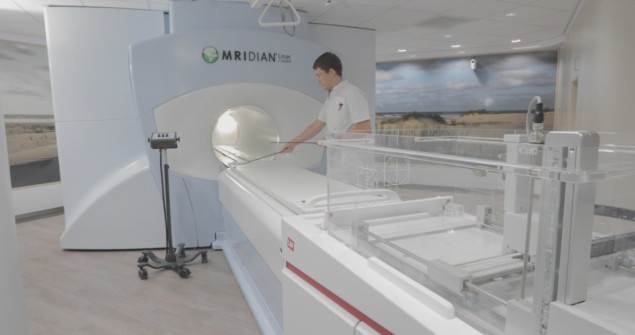The THALES 3D MR SCANNER from LAP has been developed specifically to support the commissioning and quality assurance of MR-guided radiotherapy machines

It’s still relatively early days in terms of wide-scale clinical adoption, but the benefits of the new generation of MR-guided radiotherapy (MR/RT) systems are already clear. Think real-time image-guided adaptation of radiation delivery – more effectively treating the tumour target while sparing healthy tissue and minimizing damage to adjacent organs at risk and critical structures. On the flip side, the operational challenges of a hybrid MR-Linac treatment machine are also evident – not least when it comes to the implementation of efficient and streamlined protocols for quality assurance (QA) with an MRI scanner integrated into the radiotherapy workflow.
Fundamental physics complicates matters further, with the MRI scanner’s magnetic field having a non-trivial impact on dose deposition and distribution in the irradiated volume – most importantly within the patient, but also the radiation dosimeters used for QA purposes. The QA challenge doesn’t end there. Conventional water phantoms, essential for the commissioning and annual verification of radiotherapy systems, are not suited to the unique MR-Linac environment – chiefly because, for safety reasons, the use of ferromagnetic materials is prohibited within the strong MRI magnetic field.
To address this troublesome bottleneck, laser and radiotherapy QA specialist LAP has developed a 3D and MR-compatible motorized water phantom tailored specifically for the commissioning and QA of MR-Linacs. The newly launched THALES 3D MR SCANNER is MR-conditional – i.e. all system components are made from non-ferromagnetic materials certified for use within the MRI scanner’s magnetic field – while the automated set-up (which takes under 15 minutes to prepare) and predefined measurement sequences are intended to help the medical physics team save time and simplify their test routines during system commissioning and annual or biannual QA.
“The THALES 3D MR SCANNER provides a gold-standard dose accuracy check for MR/RT users,” claims Thierry Mertens, a physicist and LAP’s business development manager for healthcare. In the radiation oncology clinic, the phantom will be used alongside a portfolio of QA tools – some providing daily, weekly and monthly QA checks, with the THALES 3D MR SCANNER reserved for system commissioning and ongoing verification of dose delivery after any major upgrades to the MR-Linac. “In this way,” adds Mertens, “the water phantom will give the medical physicist peace of mind, ensuring that their MR/RT system is accurately calibrated and supporting accurate verification of delivered dose to the patient.”
Collaborative development
Significantly, the THALES 3D MR SCANNER is now cleared for full commercial release in the US after receiving 510(k) approval from the US Food and Drug Administration (FDA), while the product’s CE mark provides a green light for roll-out to clinical customers in the European Economic Area. In both regions, the phantom comes with a yearly maintenance visit, software and hardware updates, and a configurable multiyear warranty.

These commercial milestones are the culmination of a five-year product development effort that began with LAP’s acquisition of Euromechanics Medical GmbH in summer 2016 – a purchase that, in large part, was driven by the latter’s active collaboration with MR/RT pioneer ViewRay to develop an MR-compatible phantom for the then-prototype MRIdian treatment system. That product collaboration accelerated post-acquisition, with ViewRay keen to promote the development of an independent QA ecosystem around its MRIdian machine. “Not surprisingly,” says Mertens, “the THALES 3D MR SCANNER is a perfect fit when commissioning the beam model of the MRIdian system, supporting end-users with an efficient process for accurate dosimetry measurements.”
In parallel, Mertens and his colleagues at LAP broadened the product development effort on their water phantom to gather insights from clinical early-adopters of the ViewRay MRIdian system – most notably the University Medical Centre (UMC) in Amsterdam (Netherlands), University Clinic Heidelberg (Germany) and the Henry Ford Cancer Institute in Detroit (US). “The voice of the clinical customer was fundamental to our requirements-gathering and optimization of the phantom design, usability and functionality,” says Mertens.
Put another way: as a QA vendor, it was incumbent on LAP to understand what Mertens calls “the A to Z of the clinical workflow”, thereby ensuring that the hardware, software, electronics and components of the THALES 3D MR SCANNER are all optimized versus the ViewRay MR-Linac design. “This continuous-improvement mindset is key,” adds Mertens. “The phantom has been shaped by clinical physicists at the sharp-end of treatment delivery and we continue to incorporate their feedback from the field to inform and iterate our product design.”
The view from the sharp end
While commercial roll-out of the THALES 3D MR SCANNER is now the priority, it’s also worth noting that further innovation is in the works. A custom version of the phantom to support Varian’s Halcyon image-guided radiotherapy system and ETHOS, the vendor’s new AI-enabled adaptive radiotherapy machine, is expected later this year. Down the line, a modified water phantom is also planned to provide compatibility with Elekta’s Unity MR-Linac machine.
Out in the clinic, meanwhile, Mertens predicts a variety of use-cases for the THALES 3D MR SCANNER through 2021. For starters, there are new ViewRay customers who need a suite of QA tools to support the commissioning and acceptance of their MRIdian systems. “Medical physicists are ultimately accountable,” he notes, “and they want independent QA and verification tools to confirm that what they’re getting from the radiotherapy OEM is operating as per the specification.”
Given the relative novelty of MR/RT, it’s inevitable that many clinics are newcomers to the field and, as such, are still finding their way when it comes to the unique functionality and nuances of MR-Linac machines. “As they ramp up their MR/RT programmes, I can see these customers using the THALES 3D MR SCANNER more frequently – maybe once a month at the outset – to explore the impact of the magnetic field and really get to know their treatment system,” adds Mertens.
Over time, though, it’s likely that the water phantom will be needed less often – perhaps once or twice a year as part of standard machine QA and after any significant upgrade to the MR-Linac hardware or software. Mertens concludes: “This is where the water phantom really comes into its own, helping the medical physicist with rigorous beam data and beam model visualizations to verify that the delivered radiation as it applies to the patient is indeed correct.”
- For further information, see the THALES 3D MR SCANNER tutorial video and the LAP webinar Commissioning and QA Workflows of MR-Linac with the THALES 3D MR SCANNER




